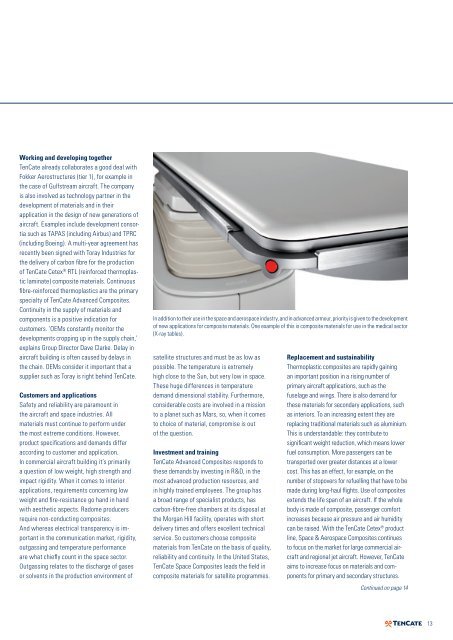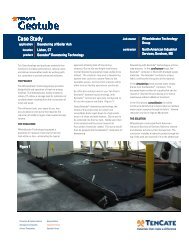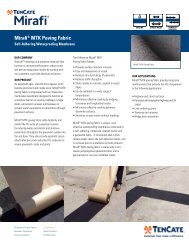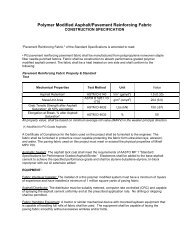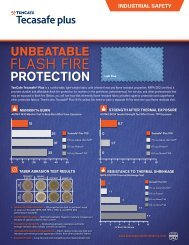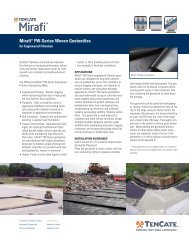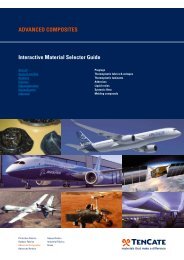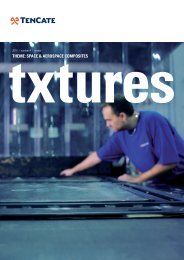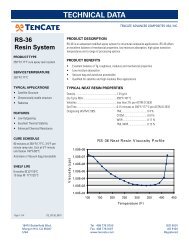end-user marketing geosynthetics / advanced composites - TenCate
end-user marketing geosynthetics / advanced composites - TenCate
end-user marketing geosynthetics / advanced composites - TenCate
Create successful ePaper yourself
Turn your PDF publications into a flip-book with our unique Google optimized e-Paper software.
Working and developing together<br />
<strong>TenCate</strong> already collaborates a good deal with<br />
Fokker Aerostructures (tier 1), for example in<br />
the case of Gulfstream aircraft. The company<br />
is also involved as technology partner in the<br />
development of materials and in their<br />
application in the design of new generations of<br />
aircraft. Examples include development consortia<br />
such as TAPAS (including Airbus) and TPRC<br />
(including Boeing). A multi-year agreement has<br />
recently been signed with Toray Industries for<br />
the delivery of carbon fibre for the production<br />
of <strong>TenCate</strong> Cetex ® RTL (reinforced thermoplastic<br />
laminate) composite materials. Continuous<br />
fibre-reinforced thermoplastics are the primary<br />
specialty of <strong>TenCate</strong> Advanced Composites.<br />
Continuity in the supply of materials and<br />
components is a positive indication for<br />
customers. ‘OEMs constantly monitor the<br />
developments cropping up in the supply chain,’<br />
explains Group Director Dave Clarke. Delay in<br />
aircraft building is often caused by delays in<br />
the chain. OEMs consider it important that a<br />
supplier such as Toray is right behind <strong>TenCate</strong>.<br />
Customers and applications<br />
Safety and reliability are paramount in<br />
the aircraft and space industries. All<br />
materials must continue to perform under<br />
the most extreme conditions. However,<br />
product specifications and demands differ<br />
according to customer and application.<br />
In commercial aircraft building it’s primarily<br />
a question of low weight, high strength and<br />
impact rigidity. When it comes to interior<br />
applications, requirements concerning low<br />
weight and fire-resistance go hand in hand<br />
with aesthetic aspects. Radome producers<br />
require non-conducting <strong>composites</strong>.<br />
And whereas electrical transparency is important<br />
in the communication market, rigidity,<br />
outgassing and temperature performance<br />
are what chiefly count in the space sector.<br />
Outgassing relates to the discharge of gases<br />
or solvents in the production environment of<br />
In addition to their use in the space and aerospace industry, and in <strong>advanced</strong> armour, priority is given to the development<br />
of new applications for composite materials. One example of this is composite materials for use in the medical sector<br />
(X-ray tables).<br />
satellite structures and must be as low as<br />
possible. The temperature is extremely<br />
high close to the Sun, but very low in space.<br />
These huge differences in temperature<br />
demand dimensional stability. Furthermore,<br />
considerable costs are involved in a mission<br />
to a planet such as Mars, so, when it comes<br />
to choice of material, compromise is out<br />
of the question.<br />
Investment and training<br />
<strong>TenCate</strong> Advanced Composites responds to<br />
these demands by investing in R&D, in the<br />
most <strong>advanced</strong> production resources, and<br />
in highly trained employees. The group has<br />
a broad range of specialist products, has<br />
carbon-fibre-free chambers at its disposal at<br />
the Morgan Hill facility, operates with short<br />
delivery times and offers excellent technical<br />
service. So customers choose composite<br />
materials from <strong>TenCate</strong> on the basis of quality,<br />
reliability and continuity. In the United States,<br />
<strong>TenCate</strong> Space Composites leads the field in<br />
composite materials for satellite programmes.<br />
Replacement and sustainability<br />
Thermoplastic <strong>composites</strong> are rapidly gaining<br />
an important position in a rising number of<br />
primary aircraft applications, such as the<br />
fuselage and wings. There is also demand for<br />
these materials for secondary applications, such<br />
as interiors. To an increasing extent they are<br />
replacing traditional materials such as aluminium.<br />
This is understandable: they contribute to<br />
significant weight reduction, which means lower<br />
fuel consumption. More passengers can be<br />
transported over greater distances at a lower<br />
cost. This has an effect, for example, on the<br />
number of stopovers for refuelling that have to be<br />
made during long-haul flights. Use of <strong>composites</strong><br />
ext<strong>end</strong>s the life span of an aircraft. If the whole<br />
body is made of composite, passenger comfort<br />
increases because air pressure and air humidity<br />
can be raised. With the <strong>TenCate</strong> Cetex ® product<br />
line, Space & Aerospace Composites continues<br />
to focus on the market for large commercial aircraft<br />
and regional jet aircraft. However, <strong>TenCate</strong><br />
aims to increase focus on materials and components<br />
for primary and secondary structures.<br />
Continued on page 14<br />
13


